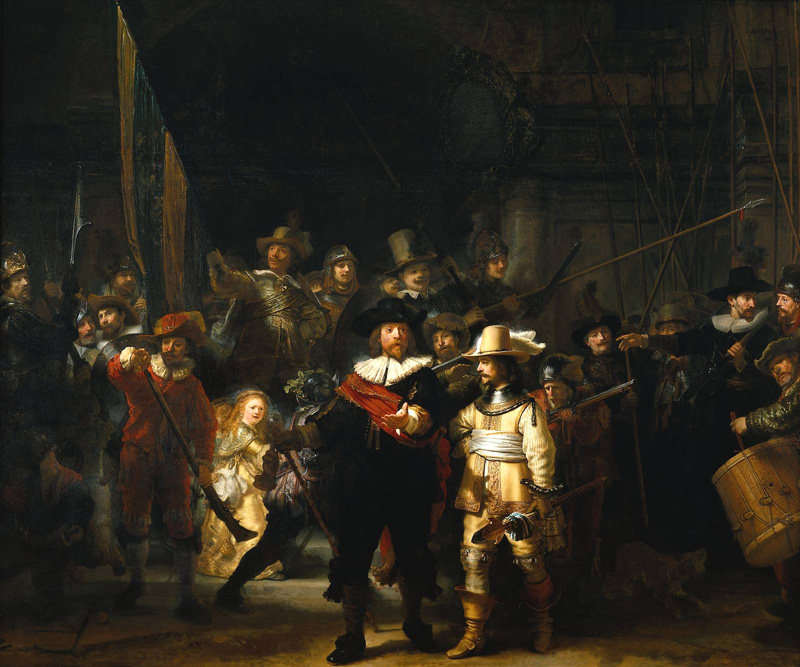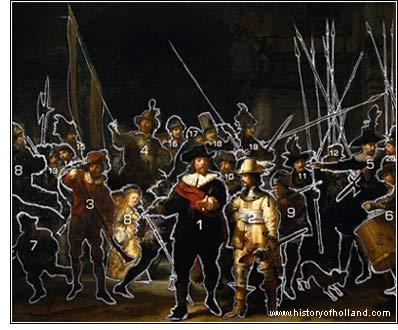
The Night Watch - Rembrandt van Rijn
(1642, Rijksmuseum, Amsterdam)
The Night Watch (Dutch: De Nachtwacht) is the common name of one of the most famous works by Dutch painter Rembrandt Harmenszoon van Rijn. The painting may be more properly titled The Company of Frans Banning Cocq and Willem van Ruytenburch. It is on prominent display in the Rijksmuseum, Amsterdam, the Netherlands, and is its most famous painting.
The painting is renowned for three elements: its colossal size (363 x 437 cm ~ 11ft 10in x 14ft 4in), the effective use of light and shadow, and the perception of motion in what would have been, traditionally, a static military portrait.
History of the Misnomer
This picture was called the "Patrouille de Nuit," by the French and the "Night Watch," by Sir Joshua Reynolds because upon its discovery the picture was so dimmed and defaced by time that it was almost indistinguishable and it looked quite like a night scene. After it was cleaned up, it was discovered to represent broad day - a party of arquebusiers stepping from a gloomy courtyard into the blinding sunlight. The popular title long seemed to appropriately reflect the content, but was based upon a misapprehension due to dulling of the painting's surface; it is, in fact, a day lit scene. For much of its existence, the painting was coated with a dark varnish which gave the incorrect impression that it depicted a night scene, leading to the name by which it is now commonly known. This varnish was removed only in the 1940s.
Since this celebrated work will always be known by an incorrect title, and since those who have not seen it continue to believe, quite logically, that it is a nocturne Company of Captain Frans Banning Cocq and Lieutenant Willem van Ruytenhurch, and not until late in the 18th Century did it acquire the name by which it is now known. Unfortunately, both "Night" and " "Watch" are wrong. The civic guards who are depicted had, by the time Rembrandt painted them, become quite pacific; it was no longer necessary for them to defend the ramparts of Amsterdam or to go out on watches by night or by day. Their meetings had been diverted chiefly to social or sporting purposes; if they may be said to have any particular destination in the painting, it is perhaps to march into the fields for a shooting contest or to take part in a parade.
"Night" is even less apt than "Watch." When the critics and the public attached that word to the painting, the canvas had become so darkened by dirt and layers of varnish that it was difficult to tell whether the illumination Rembrandt had provided in it came from the sun or moon. Not until after the end of World War II was the painting fully restored so that the viewer could get an idea of the brightness it had when it left Rembrandt's hand more than 300 years before. (Upon seeing the refreshed work, journalists promptly re-christened it the "Day Watch.")
The Night Watch was commissioned by Captain Barining Cocq and 17 members of his civic guards; that this was the total of Rembrandt's clients for the work is assumed from the fact that 18 names, added by an unknown hand after the painting was completed, appear on a shield on the background wall. Doubtless the guardsmen expected a group portrait in which each member would be clearly recognizable, although perhaps not of equal prominence; it was often the practice for less affluent or junior members of a group to be represented only by heads or partial figures, for which they paid less than did those who were portrayed full length. The guardsmen, may also have foreseen that the artist would not produce a standard, static painting. But none of them could have been prepared for the thunderous masterwork with which they were confronted.
Who's Who in the Painting

- 01. Captain Frans Banning Cocq
- 02. Lieutenant Willem van Ruytenburch
- 03. Musketeer
- 04. Ensign bearer, Jan Visscher Cornelissen
- 05. Sergeant Rombout Kemp
- 06. Drummer
- 07. Boy
- 08. Girl in yellow dress with chicken
- 09. Musketeer
- 10. Musketeer
- 11. Jacob Dircksen de Roy
- 12. Musketeer
- 13. Musketeer
- 14. Musketeer
- 15. Eldest Musketeer
- 16. Jung Musketeer
- 17. Musketeer
- 18. Musketeer
- 19. Musketeer
- 20. Musketeer in conversation with Kemp (05)
The two first personages are Frans Banning-Cocq, Lord of Furmerland and Ilpendam, captain of the company, and his lieutenant, Willem van Ruijtenberg, Lord of Vlaardingen, the two marching side by side. The only figures that are in the light are this lieutenant, dressed in a doublet of buffalo-hide, with gold ornaments, scarf, gorget, and white plume, with high boots. And a girl with blond hair ornamented with pearls, and a yellow satin dress; all the other figures are in the dark, excepting the heads, which are illuminated. By what light? Here is the enigma. Is it the light of the sun? or of the moon? or of the torches? There are gleams of gold and silver, moonlight colored reflections, fiery lights; personages which, like the girl with blond tresses, seem to shine by a light of their own.... The more you look at it, the more it is alive and glowing; and, even seen only at a glance, it remains forever in the memory, with all its mystery and splendor, like a stupendous vision." Charles Blanc has said: "To tell the truth, this is only a dream of night, and no one can decide what the light is that falls on the groups of figures. It is neither the light of the sun or of the moon, nor does it come from the torches; it is rather the light from the genius of Rembrandt."
The powerful contrast of light and shade heightens the sense of movement, but it is well to regard Rembrandt's use of light in this painting, as in many others, from an esthetic rather than from a strictly logical view- point. He was, in the phrase of one critic, "his own sun-god." The shadow cast by the captain's hand on the lieutenant's coat might suggest that the sun is at an apparent angle of about 45 degrees to the left, but the shadow of the captain's extended leg indicates quite a different angle. The picture was of course composed and painted indoors, not while the officers posed for him out of doors, and although his lighting in any particular detail may be true to nature, that is not the case overall. He regulated and manipulated light-opening or closing the shutters in his studio-for his own purpose, which was to create an atmosphere both dreamlike and dramatic.
The "Night Watch" was painted in 1642 and many of the Kloveniers (civic militia guards) guild who gave Rembrandt the commission would not pay their share because their faces were not plainly seen. Still, Rembrandt was paid 1,600 guilders for the painting (each person paid one hundred), a large sum at the time. This picture which alone was enough to make him immortal, was the very last commission that any of the guilds were willing to give the artist, because he would not make their portraits beautiful or fine looking to the disadvantage of the whole picture.
A Myth like a Phoenix
The Night Watch lies at the center of the most persistent and annoying of all Rembrandt myths. As recently as the tourist season of 1967, KLM Royal Dutch Airlines featured the painting by their illustrious countryman in an advertisement inviting travelers to visit Holland. "See Night Watch," said the advertisement, "Rembrandt's spectacular 'failure' (that caused him to be) hooted ...down the road to bankruptcy." The myth has been attacked by various critics, and a few years ago it was utterly demolished by Professor Seymour Slive of Harvard in Rembrandt and His Critics. But since the tale has a phoenix-like capacity for self-resurrection, a few of Professor Slive's observations will bear repeating here:
The painting was not poorly received; no critic during Rembrandt's lifetime wrote a word in dispraise of it. Captain Banning Cocq himself had a watercolor made of it for his personal album, and a contemporary oil copy of it by Gerrit Lundens, now owned by the National Gallery in London, offers further proof of the picture' s popularity. The Night Watch was never hidden in some obscure location; it was first hung in the Kloveniersdoelen, the headquarters of the civic guardsmen, and in 1715 it was moved to the Amsterdam town hall, as prominent a place as could have been found for it. (Probably on the occasion of its transferal, but no doubt for reasons of space, the painting was cut down on all four sides. The greatest loss was on the left, where a strip about two feet wide, containing three figures, was removed. Nor did painting this supposed "failure" result in any abrupt withdrawal of patronage; Rembrandt received about 1,600 guilders for the Night Watch, and four years later the Prince of Orange gave him 2,400 for two smaller works.
The fable of the Night Watch may owe its stubborn survival to the fact that it is a simple and convenient means of disposing of a complex matter. In 1642 Rembrandt was at the height of his popularity, and thereafter he slowly fell out of public favor, though never to the extent that romantic biographers suggest. What were the reasons for his "decline"? One of them, certainly, was a change in Dutch tastes in art. During the 1640s wealthy citizens, perhaps growing a trifle soft in their security, developed a fondness for showiness and elegance. They began to prefer the bright colors and graceful manner that had been initiated by such painters as the fashionable Flemish portraitist Anthony van Dyck- who, however fine an artist, lacked Rembrandt' s depth. Rembrandt's use of chiaroscuro dissatisfied them too, and they turned away from an artist who seemed "dark" and-what was perhaps worse-demanded that they devote some thought to what they were looking at.
Points of Interest
The work was attacked with a bread knife by an unemployed school teacher, Wilhelmus de Rijk, in 1975, resulting in a large zig-zag of slashes. It was successfully restored but some evidence of the damage is still observable in person. De Rijk committed suicide in April 1976.
In 1990, a man sprayed acid onto the painting with a concealed pump bottle. Security guards intervened and water was quickly sprayed onto the canvas. Luckily, the acid had only penetrated the varnish layer of the painting and the painting was fully restored.
It was first hung in the Kloveniersdoelen in Amsterdam in the Groote Zaal (Great Hall). This is now known as the Doelen Hotel. In 1715 it was moved to the Amsterdam town hall, for which it was altered. When Napoleon occupied the Netherlands, the town hall became the Palace on the Dam. The magistrates moved the painting to the Trippenhuis of the family Trip. Napoleon ordered it back, but after the occupation the painting was moved to the Trippenhuis again, which had now become the Rijksmuseum, and was moved to the new Rijksmuseum building when it was finished in 1885. Its last major movement was during the Second World War, when it was kept in a secure bunker under the hills of Limburg for over five years, detached from its frame and rolled around a cylinder. It was restored to the Rijksmuseum after the war.